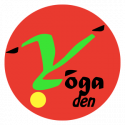Teaching Methodology in Yoga Teacher Training
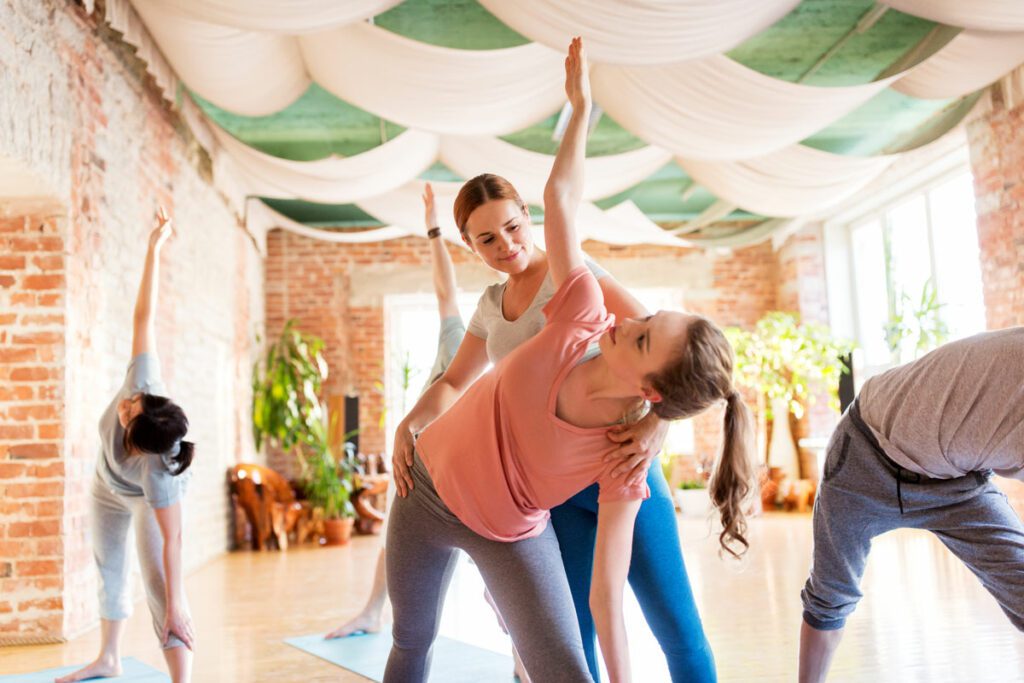
Yoga teacher training plays a vital role in equipping aspiring teachers with the necessary skills and knowledge to impart the teachings of yoga to their students effectively. A comprehensive understanding of teaching methodology is essential for yoga teachers to create a safe, structured, and transformative learning environment.
This article aims to provide an in-depth exploration of teaching methodology in various styles of yoga, including Hatha, Vinyasa, Ashtanga, Iyengar, Kundalini, Yin, and Restorative yoga. By delving into the intricacies of each methodology, this article seeks to empower yoga teachers with a comprehensive toolkit of instructional techniques, sequencing principles, and adjustments specific to each style.
Drawing upon extensive research and expert insights, this article will offer a knowledgeable and detailed analysis of teaching methodology, catering to an audience that seeks mastery in the field of yoga education.
Key Takeaways
- *Kundalini Yoga methodology focuses on awakening dormant Kundalini energy through physical postures, breathing exercises, mantras, and meditation.
- *Awakening the Kundalini energy involves techniques to activate dormant energy and stimulate upward movement along the spine, leading to heightened awareness and spiritual growth.
- *Mantras and meditation play an essential role in Kundalini yoga teacher training as they create vibrational resonance, help focus the mind, induce a meditative state, reduce stress, and deepen spiritual practice.
- *Yin Yoga methodology focuses on long-held passive poses that target deep connective tissues, improving flexibility, joint mobility, promoting relaxation, and reducing stress.
Hatha Yoga Methodology
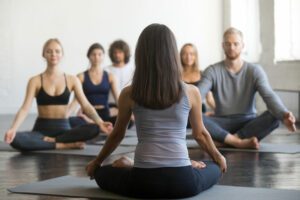
Rooted in the ancient Hatha yoga philosophy, this methodology emphasizes the balance between the physical body and the mind. Hatha yoga techniques involve practicing asanas (physical postures) to strengthen and stretch the body, pranayama (breathing exercises) to regulate the breath and increase energy flow, and dhyana (meditation) to cultivate mindfulness and inner peace.
Through the systematic practice of Hatha yoga, students develop flexibility, strength, and endurance while also improving mental focus and emotional stability.
Vinyasa Yoga Methodology
Vinyasa Yoga Methodology is characterized by flowing sequences and dynamic movements. This style of yoga emphasizes the seamless transition between poses, creating a continuous flow of movement.
Vinyasa Yoga strongly emphasizes syncing breath with movement, with breath acting as a guide for each transition. This methodology allows practitioners to cultivate a sense of mindfulness and focus as they move through a series of poses with intention and awareness.
Flowing Sequences and Dynamic Movement
Incorporating fluid sequences and dynamic movements into yoga teacher training programs enhance practitioners’ ability to engage their body and mind, fostering a more immersive and enjoyable yoga experience.
The dynamic movement incorporates flowing and continuous sequences that challenge the body’s strength, flexibility, and balance. Yoga teachers can design classes that continually evolve and keep students engaged by encouraging creative sequencing. This approach helps students build physical strength and stamina and cultivates mental focus and presence.
Flowing sequences allow practitioners to move through poses seamlessly, creating a sense of rhythm and grace in their practice. These dynamic movements also promote the exploration of different postures and transitions, providing a well-rounded and varied yoga experience.
Syncing Breath with Movement
Synchronizing breath with movement is akin to a gentle breeze guiding a sailboat, effortlessly propelling the practitioner through their yoga practice. This fundamental aspect of yoga requires the practitioner to coordinate their breath with each movement, creating a harmonious flow between body and breath.
Breathwork techniques, such as ujjayi pranayama, are employed to cultivate a deep, rhythmic breath that aids in concentration and focus. By synchronizing breath with movement, practitioners cultivate mindfulness in movement, bringing their attention to the present moment and enhancing the mind-body connection.
This mindful awareness allows for a more profound experience of the yoga practice, as it encourages the practitioner to move with intention and grace. Incorporating breath in yoga teacher training emphasizes the importance of breath awareness and its role in enhancing the overall yoga experience.
Ashtanga Yoga Methodology
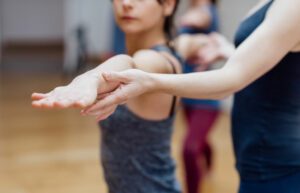
The primary series practice is designed to purify the body by building strength, flexibility, and stamina. It begins with sun salutations and moves through a series of standing, seated, and finishing poses.
Ashtanga yoga sequencing follows a precise order, with each posture building on the previous one to create a continuous flow of movement. This method emphasizes the synchronization of breath with movement, creating a dynamic and meditative practice.
Practitioners of Ashtanga yoga often find that the structured nature of the methodology helps them develop discipline, focus, and a deep understanding of the mind-body connection.
Iyengar Yoga Methodology
Iyengar Yoga is a style of yoga that emphasizes precise alignment and the use of props to support and enhance the practice.
The focus on alignment ensures that each pose is performed correctly, which helps to prevent injuries and allows for a deeper exploration of the body’s potential.
Iyengar Yoga has a therapeutic approach, with poses and sequences specifically designed to address various physical and mental health conditions. This approach makes Iyengar Yoga accessible to individuals of all ages and abilities, as it can be adapted to suit individual needs.
Precise Alignment and Use of Props
Propriety in the precise placement and proficient use of props are paramount in promoting alignment and attaining optimal postural integrity in yoga practice. The Iyengar Yoga Methodology emphasizes the importance of precise alignment and the use of props to support practitioners in achieving correct alignment in each pose.
Props such as blocks, straps, and bolsters are used to modify poses and provide support where needed. This meticulous approach ensures that students can safely and effectively progress in their practice, as it helps prevent injuries and promotes body awareness.
The use of props also allows for a deeper exploration of the asanas, enabling practitioners to go beyond their limitations and experience the full benefits of each pose.
Therapeutic Approach to Yoga
A therapeutic approach to yoga focuses on addressing physical and mental imbalances through postures and breathwork, providing a holistic avenue for healing and cultivating overall well-being.
This approach recognizes that yoga can have therapeutic benefits beyond physical fitness and flexibility. Individuals can target and release tension, reduce stress, and promote relaxation by incorporating specific healing practices, such as restorative poses, gentle stretches, and breath awareness.
The therapeutic approach emphasizes mindfulness and self-awareness, allowing practitioners to connect with their bodies, emotions, and thoughts on a deeper level. Through this connection, individuals can gain insights into their own patterns and habits, facilitating personal growth and transformation.
Kundalini Yoga Methodology
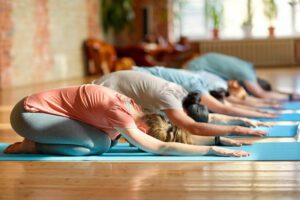
In addition to physical postures and breathing exercises, Kundalini Yoga incorporates the use of mantras and meditation to facilitate the awakening and flow of this energy throughout the body.
Mantras are repetitive sounds or words that are chanted or silently repeated to focus the mind and cultivate specific qualities or states of consciousness.
Meditation in Kundalini Yoga involves various techniques, such as focusing on the breath, visualizations, and mantra repetition, to quiet the mind and deepen the connection with one’s inner self.
Awakening the Kundalini Energy
The process of awakening the Kundalini energy involves a series of techniques and practices that aim to activate the dormant energy within the body and stimulate its upward movement along the spine.
These awakening techniques typically include various physical postures, breathing exercises, and specific meditation practices. By channeling and directing the Kundalini energy, practitioners can experience various benefits, including increased vitality, heightened awareness, improved focus, and a deeper sense of connection to oneself and the world.
The awakening of Kundalini energy is often described as a transformative experience, as it can lead to profound spiritual growth and a greater understanding of one’s true nature.
Incorporation of Mantras and Meditation
Through the incorporation of mantras and meditation, practitioners of Kundalini Awakening can deepen their spiritual practice and cultivate a heightened state of awareness. Mantras, sacred sounds, or words repeated during meditation are believed to have a powerful effect on the mind and body.
When chanted or silently repeated, mantras can create a vibrational resonance that promotes healing and transformation. They can also help to focus the mind and induce a meditative state. Meditation, on the other hand, is a practice of quieting the mind and entering a state of deep relaxation.
It has been widely recognized for reducing stress, improving concentration, and enhancing overall well-being. By incorporating mantras and meditation into the Kundalini awakening process, practitioners can tap into the transformative power of these practices and experience profound spiritual growth.
Mantras for Healing | Meditation for Stress Relief |
Promotes healing | Reduces stress |
Creates resonance | Improves concentration |
Focuses the mind | Enhances well-being |
Transforms | Cultivates awareness |
Facilitates growth | Deepens spiritual practice |
This integration of mantras and meditation is an essential aspect of the teaching methodology in Kundalini yoga teacher training. It equips aspiring teachers with the knowledge and skills to guide their students toward a more profound understanding of themselves and the world around them.
Yin Yoga Methodology
Yin Yoga methodology focuses on long-held, passive poses that target deep connective tissues in the body. These poses are typically held for several minutes, allowing for a slow and gentle stretch of the targeted areas.
By targeting the deep connective tissues, Yin Yoga helps to improve flexibility and increase joint mobility while also promoting relaxation and stress reduction.
Long-held Passive Poses
Long-held, passive poses in yoga teacher training provide an opportunity for practitioners to explore deep relaxation and release tension in the body. These poses involve holding a position for an extended period, typically between three to five minutes, allowing the muscles to relax and the body to sink into the pose.
This extended duration enables practitioners to reach a state of stillness and introspection, promoting a sense of calm and tranquility. Moreover, long-held, passive poses target the deep connective tissues, such as ligaments, tendons, and fascia, which are not typically stretched in more dynamic styles of yoga.
By gently applying sustained pressure to these tissues, practitioners can enhance flexibility and joint mobility while also improving circulation and reducing stress.
Targeting Deep Connective Tissues
Targeting deep connective tissues in yoga practice involves applying sustained pressure to these tissues to enhance flexibility and joint mobility while also improving circulation and reducing stress.
By holding long-held, passive poses, practitioners can access these deep tissues and release tension that may be stored there. This type of practice is particularly beneficial for individuals who are looking to increase their flexibility and experience deep relaxation.
To understand the benefits of targeting deep connective tissues in yoga practice, examining the effects on the body is helpful. The sustained pressure applied to these tissues stimulates collagen production, which helps improve the elasticity and strength of the connective tissues. This type of practice increases blood flow to the targeted areas, promoting healing and rejuvenation.
To effectively target deep connective tissues, it is important to use proper alignment and engage in poses that specifically target these areas. A table highlighting different poses and their corresponding target areas can provide a visual reference for practitioners to incorporate into their practice.
Restorative Yoga Methodology
Restorative yoga methodology involves using gentle poses and props to promote deep relaxation and healing in the body and mind. Restorative yoga has numerous benefits, including stress reduction, increased flexibility, improved circulation, and enhanced sleep quality.
This practice is particularly beneficial for individuals recovering from injuries or experiencing chronic pain, as it allows for gentle stretching and relaxation of the deep connective tissues.
Restorative yoga props such as bolsters, blankets, and blocks provide support and stability, allowing practitioners to hold poses for longer periods without strain.
These props also help to create a safe and comfortable environment, enabling individuals to surrender and let go in each pose fully.
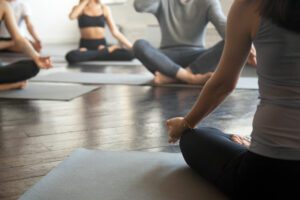
Conclusion
The teaching methodology in Yoga Teacher Training plays a paramount role in shaping competent and effective instructors. By blending traditional wisdom with contemporary approaches, aspiring teachers gain a comprehensive understanding of not only the yogic postures but also the philosophy and principles that underpin this ancient practice.
The emphasis on alignment, adjustments, and effective communication equips them to cater to diverse students’ needs and abilities. Fostering a compassionate and inclusive learning environment cultivates a deep sense of connection between teachers and their students, promoting personal growth and transformation along the yogic journey.
A well-crafted teaching methodology paves the way for inspiring and authentic yoga educators.
